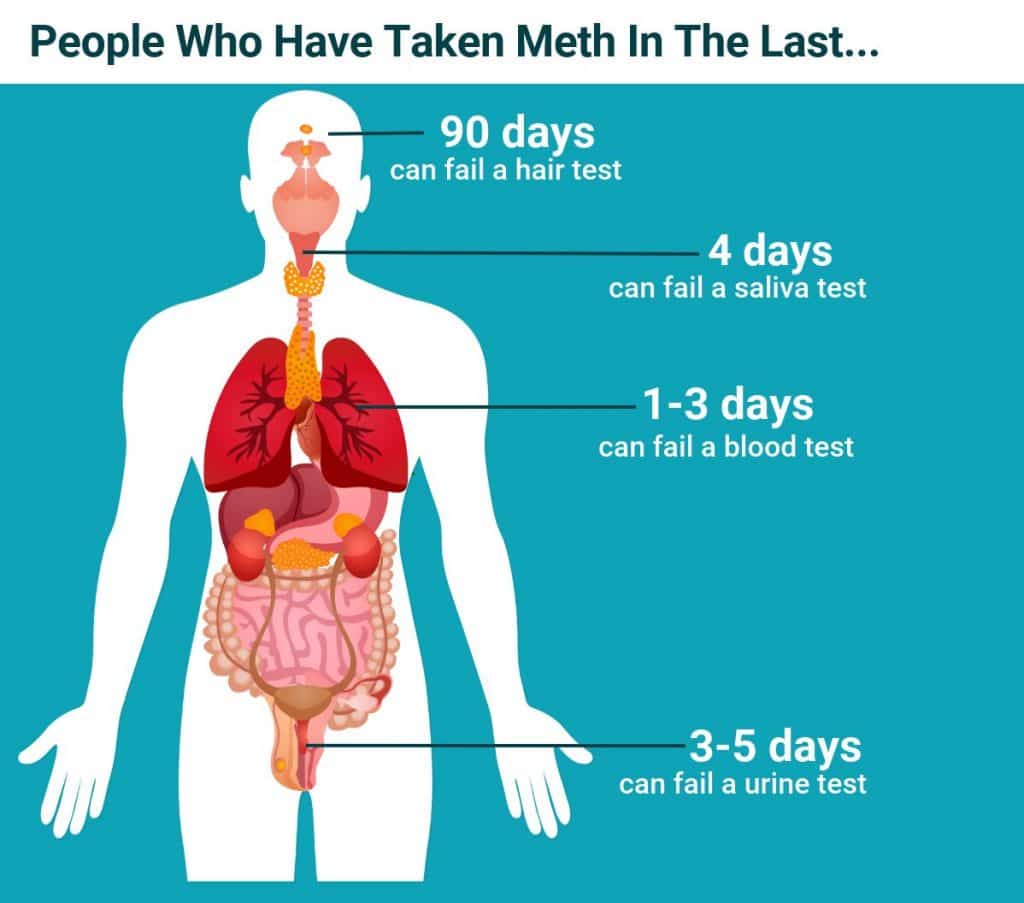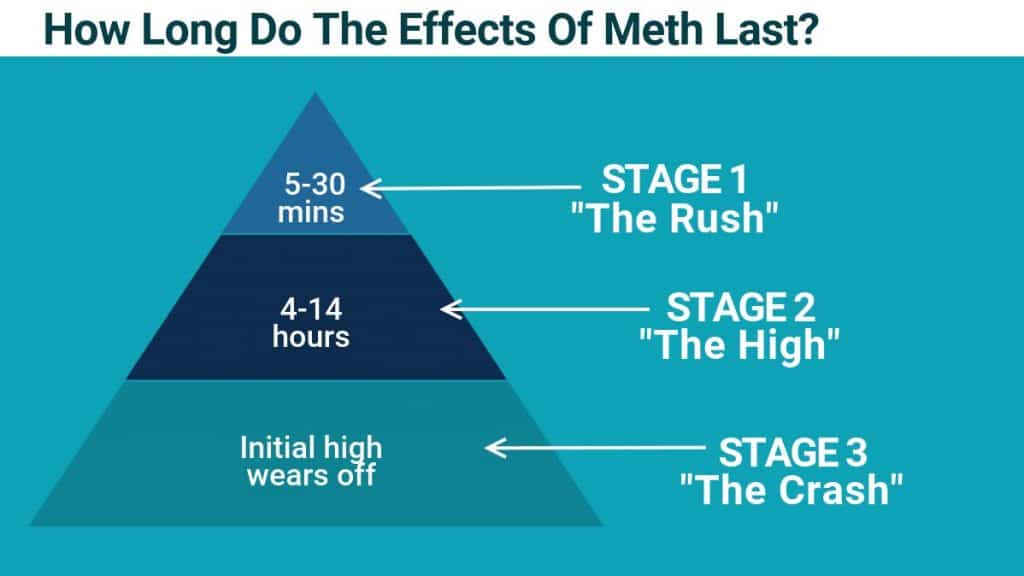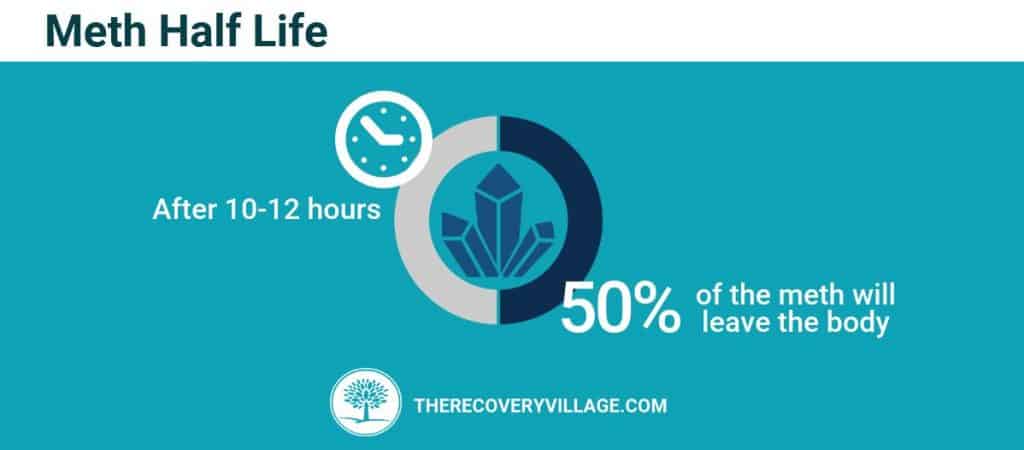Meth can be detected in urine, blood, saliva and even hair for different periods of time that vary from person to person. In general, it’s much longer than you’d expect.
Although thehigh from methmay last only a few minutes to a few hours, the drug can remain in your body for a much longer period of time. Even after the high wears off, your liver remains hard at work breaking down the substance so that it can be removed from your system. This may lead you to wonder how long meth stays in your body and how long it can be detected on drug tests.
Article at a Glance:
- The initial rush from meth can last up to 30 minutes, and the high can last up to 16 hours.
- Meth can stay in your urine for up to five days.
- Meth can be found in half-inch hair samples for up to 90 days.
Average Meth Detection Times by Type of Drug Test
There are various ways to detect methamphetamine use, as well as a number of factors that can determine what a detection test may find.

How Long Does Meth Stay in Urine?
This testing method is common as it is relatively non-invasive and quick. The person being tested urinates in a cup, and the contents are then tested to determine the levels of different substances present in their urine. Meth can be detected by a urine testbetween one and five daysafter the last use.
How Long Does Meth Stay in Your Blood?
Based on itshalf-life of up to five hours, meth can be detected in the blood for around 25 hours after the last use.
Treatment Can Be Life Changing. Reach out today.
Whether you are struggling with addiction, mental health or both, our expert team is here to guide you every step of the way. Don’t wait— reach out today to take the first step toward taking control of your life.
How Long Does Meth Stay in Your Saliva?
Saliva testing involves a swab of the mouth or tongue with an absorbent material. Detection time for saliva testing can beas long as two daysafter the last use.
How Long Does Meth Stay in Your Hair?
Hair tests can be used to detect meth. A 1.5-inch sample of hair can detect meth takenup to 90 daysprior.
How Long Does Meth Stay in Breastmilk?
Meth can stay in breastmilk forup to 72 hoursafter the last use. For this reason, mothers who use meth are discouraged from breastfeeding. If a mother has recently used meth and wants to breastfeed, they should wait 48 to 100 hours after the last time meth was used. However, if a urine screen shows no meth in the system, the mother can resume breastfeeding earlier.
How Long Does Meth Stay in Your Nails?
Meth can be detected in fingernails forthree to six monthsafter the last use.
Factors That Influence How Long Meth Stays in Your System
Detection times can vary from person to person. Some common factors influencing this may include, but are not limited to, the amount used and overall health.

The quantity and frequency of methamphetamine use influence the length of time the drug remains in your body. If someone uses meth often and in large amounts, it will take their body a longer period of time to eliminate the drug from its system.
Having good overall health can influence your body’s ability to rid itself of substances. If you’re an overall healthy person, your liver may work more efficiently, so the elimination of toxins will occur at a faster rate than someone who is unhealthy.
How Long Does Meth Last?
After a person takes meth, they often experience several stages of a meth high before crashing. The duration of these effects can vary. However, they generally occur in a predictable order as your body is exposed to the drug and starts to break it down.

1st Stage: The Rush
The first stage occurs after you initially ingest meth and is referred to as “the rush.” This occurrence is a result of a sudden flood of dopamine into the brain. During this time, your heart quickens, pupils dilate, and your blood pressure and metabolism increases. The first stage can lastup to 30 minutes.
2nd Stage: The High
After the initial rush, you will experience the second stage: the high. The high from meth can last fromfour to 16 hoursand is characterized by hyperactivity and rapid thinking patterns. Other visible side effects of someone who has used meth and is experiencing a high include aggressive or obsessive-compulsive behavior, and confusion, or the lack of ability to form coherent sentences.
3rd Stage: The Binge
It is common for someone who abuses meth to go through the next stage, called binging, to avoid crashing when the high wears off. Binging can last fromthree to 15 days, during which time the person often avoids eating. In arecent studyof meth users, 67% used meth several times a week, and 23% try never leave their binge by using multiple times per day, every day.
4th Stage: The Tweak
The last stage of meth intoxication, sometimes consideredthe most dangerous, is tweaking. During tweaking, the high has worn off and side effects like itching are common. Further, a person can become increasingly frustrated, paranoid and unstable due to going several days without sleep. People going through this stage are typically unpredictable. Some individuals develop meth psychosis and are at higher risk for self-harm.
5th Stage: The Crash
During a meth crash, the body finally shuts down after being overstimulated from the meth high. This stage can last fromone to three days, and involves excessive fatigue and sleep. Crashing also occurs when you stop taking meth. For most meth users, they experience their crash within thefirst ten daysof stopping.
6th Stage: The Hangover
A meth hangover often follows the crash. After sleeping for several days after getting high, theperson often suffersfrom dehydration, hunger, and both mental and physical exhaustion. This stage lasts for up to 14 days. During a meth hangover, a person may attempt to take more meth to feel better.
7th Stage: Withdrawal
Meth withdrawal can be a slow process and can beongoing for up to 90 daysbefore a person even begins to recognize their symptoms. Withdrawal is linked to symptoms like depression, lack of energy, and lack of pleasure. Cravings are also common during this time, leading many people to continue to take meth. In arecent studyof meth users by The Recovery Village, the vast majority (95%) of all participants experienced cravings for up to seven weeks, so most people can expect their cravings will calm down in the first or second month after stopping meth use.

Time's up
Meth Half-Life: Understanding How Your Body Metabolizes Methamphetamine
Almost immediately after you use meth, your body starts to break down the substance as it goes through the bloodstream. After a few hours, meth usually passes through the liver and kidneys and is excreted through urination.About a thirdof ingested meth can leave your body just as potent as it was when it entered. In other words, some meth isn’t metabolized at all.

If you have a meth use disorder and are entering a rehabilitation center, you may want to know when you’ll start experiencing withdrawal symptoms. Thehalf-life of meth in the bloodstream is four to five hoursfor most people.
It takes aboutfive half-livesfor a drug to be fully cleared from your system. As a result, it can take up to around 25 hours for meth to fully clear from your bloodstream. However, the drug and its chemical breakdown products can be detected in other fluids in your system, like urine, for longer.
How to Get Meth Out of Your System
Becausemeth needs to be processed by your liver before it leaves the body, there is nothing you can do to get the drug out of your system once you have taken it. Avoiding further use will stop more of the drug from building up in your body, giving your liver a chance to clear the drug. However, stopping meth suddenly, especially after long-term use, can cause withdrawal symptoms.
Meth Withdrawal and Detox
Meth withdrawal can cause a variety of unpleasant symptoms.These include:
- Agitation
- Depression
- Increased appetite
- Achy muscles
- Paranoia
- Hallucinations
Most meth withdrawal symptoms last betweenone and two weeks. However, psychological withdrawal symptoms, like decision-making problems, can continue over the long-term.
Although it may be tempting to detox from meth at home, this is not recommended. Psychiatric withdrawal symptoms like paranoia and hallucinations can be challenging and dangerous to manage at home.
Getting Help For Meth Addiction
Being worried about failing a drug test can be a sign that your substance use is spinning out of control. If you or someone you know struggles with meth, help is available. At The Recovery Village, our staff of professionals offers a number of treatment programs that fit your individual needs. Contact us to learn more about what treatment program could work for you.








